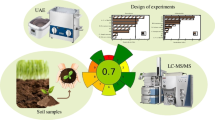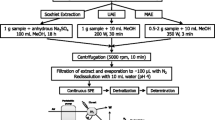Abstract
It is essential to monitor pesticides in soils as their presence at trace levels and their bioavailability can induce adverse effects on soil’s ecosystems, animals, and human health. In this study, we developed an analytical method for the quantification of traces of multi-class pesticides in soil using liquid chromatography-tandem mass spectrometry. In this way, 31 pesticides were selected, including 12 herbicides, 9 insecticides, and 10 fungicides. Two extraction techniques were first evaluated, namely, the pressurized liquid extraction and the QuEChERS procedure. The latest one was finally selected and optimized, allowing extraction recoveries of 55 to 118%. The role of the chelating agent EDTA, which binds preferentially to soil cations that complex some pesticides, was highlighted. Coupled with liquid chromatography-tandem mass spectrometry, the procedure displayed very high sensitivity, with limits of quantification (LOQ) in the range 0.01–5.5 ng/g. A good linearity (R2 > 0.992) was observed over two orders of magnitude (LOQ-100 \(\times\) LOQ) with good accuracy (80–120%) for all compounds except the two pyrethroids lambda-cyhalothrin and tau-fluvalinate (accuracy comprised between 50 and 175%) and the cyclohexanedione cycloxydim (accuracy < 35%). Good repeatability and reproducibility were also achieved. The method was finally successfully applied to 12 soil samples collected from 3 land-use types. Among the 31-targeted pesticides, 24 were detected at least once, with concentration levels varying from LOQ to 722 ng/g. Many values were below 0.5 ng/g, indicating that the developed method could provide new knowledge on the extremely low residual contents of some pesticides.




Similar content being viewed by others
Data availability
N/A, data supporting the results reported in the article can be found in the figures and tables included in this paper.
References
Alcantara-Licudine JP, Kawate MK, Li QX (1997) Method for the analysis of phloxine B, uranine, and related xanthene dyes in soil using supercritical fluid extraction and high-performance liquid chromatography. J Agric Food Chem 45:766–773
Alleva R, Manzella N, Gaetani S, Bacchetti T, Bracci M, Ciarapica V, Monaco F, Borghi B, Amati M, Ferretti G, Tomasetti M (2018) Mechanism underlying the effect of long-term exposure to low dose of pesticides on DNA integrity. Environ Toxicol 33:476–487
Aloizou AM, Siokas V, Vogiatzi C, Peristeri E, Docea AO, Petrakis D, Provatas A, Folia V, Chalkia C, Vinceti M, Wilks M, Izotov BN, Tsatsakis A, Bogdanos DP, Dardiotis E (2020) Pesticides, cognitive functions and dementia: A review. Toxicol Letters 326:31–51
Avendaño MC, Roqué P, Palomeque ME (2018) An efficient extraction method of persistent organic pesticides in soil samples for their chromatographic determination. Soil Sed Contam 27(5):426–438
Campbell S, Li QX (2001) Na4EDTA-assisted in situ derivatization pressurized fluid extraction of polar herbicides in soil. Anal Chim Acta 434:283–289
Chiaia-Hernandez AC, Keller A, Wächter D, Steinlin C, Camenzuli L, Hollender J, Krauss M (2017) Long-term persistence of pesticides and TPs in archived agricultural soil samples and comparison with pesticide application. Environ Sci Technol 51(18):10642–10651
David MD, Campbell S, Li QX (2000) Pressurized fluid extraction of nonpolar pesticides and polar herbicides using in situ derivatization. Anal Chem 72:3665–3670
Di S, Shi S, Xu P, Diao J, Zhou Z (2015) Comparison of different extraction methods for analysis of 10 organochlorine pesticides: application of MAE-SPE method in soil from Beijing. Bull Environ Contam Toxicol 95(1):67–72
Domínguez AM, Funes M, Fadic X, Placencia F, Cereceda F, Muñoz JP (2015) Evaluation of a buffered solid phase dispersion procedure adapted for pesticide analyses in the soil matrix. Quim Nova 38(7):884–890
EC (2015). Analysis of acidic pesticides using QuEChERS 696 (EN15662) and acidified QuEChERS method. 2015. EU Reference Laboratories for Residues of Pesticides, Fellbach, Germany, 2015
Joseph L, Paulose SV, Cyril N, Santhosh SK, Varghese A, Nelson AB, Kunjankutty SV, Kasu S (2020) Organochlorine pesticides in the soils of Cardamom Hill Reserve (CHR), Kerala, India: geo spatial distribution, ecological and human health risk assessment. Environ Chem Ecotoxicol 2:1–11
Gaston LA, Locke MA (2001) Comparison of methodologies for extraction of acifluorfen from soil. Comm Soil Sci Plant Anal 32:2953–2964
Hvězdová M, Kosubová P, Košíková M, Scherr KE, Šimek Z, Brodský L, Šudoma M, Škulcová L, Sáňka M, Svobodová M, Krkošková L, Vašíčková J, Neuwirthová N, Bielská L, Hofman J (2018) Currently and recently used pesticides in Central European arable soils. Sci Tot Environ 613–614:361–370
Kalyabina VP, Esimbekova EN, Kopylova KV, Kratasyuk VA (2021) Pesticides: formulants, distribution pathways and effects on human health – a review. Toxicol Reports 8:1179–1192
Karasali H, Marousopoulou A, Machera K (2016) Pesticide residue concentration in soil following conventional and low-input crop management in a Mediterranean agro-ecosystem, in Central Greece. Sci Tot Environ 541:130–142
Kemmerich M, Bernardi G, Adaime MB, Zanella R (2015) A simple and efficient method for imidazolinone herbicides determination in soil by ultra-high performance liquid chromatography-tandem mass spectrometry. J Chromatog A 1412:82–89
Łozowicka B, Rutkowska E, Jankowska M (2017) Influence of QuEChERS modifications on recovery and matrix effect during the multi-residue pesticide analysis in soil by GC/MS/MS and GC/ECD/NPD. Environ Sci Poll Res 24:7124–7138
Masiá A, Vásquez K, Campo J, Picó Y (2015) Assessment of two extraction methods to determine pesticides in soils, sediments and sludges. Application to the Túria River Basin. J Chromatogr A 1378:19–31
Muhammad M, Jan MR, Shah J, Ara B, Akhtar S, Rahman HU (2017) Evaluation and statistical analysis of the modified QuEChERS method for the extraction of pinoxaden from environmental and agricultural samples. J Anal Sci Technol 8:12
Panis C, Bufalo Kawassaki AC, Crestani APJ, Pascotto CR, Bortoloti DS, Vicentini GE, Lucio LC, Ferreira MO, Cunha Prates RT, Vieira VK, Gaboardi SC, Pessoa Candiotto LZ (2022) Evidence on human exposure to pesticides and the occurrence of health hazards in the brazilian population: a systematic review. Front Publ Health 9:787438. https://doi.org/10.3389/fpubh.2021.787438
Pastor-Belda M, Garrido I, Campillo N, Viñas P, Hellín P, Flores P, Fenoll J (2015) Dispersive liquid–liquid micro extraction for the determination of new generation pesticides in soils by liquid chromatography and tandem mass spectrometry. J Chromatogr A 1394:1–8
Pose-Juan E, Herrero-Hernández E, Álvarez-Martín A, Sánchez-Martín MJ, Rodríguez-Cruz MS (2014) Development of a procedure for the multi-residue analysis of pesticides in vineyard soils and its application to real samples. J Sep Sci 37:2215–2224
Qu C, Albanese S, Li J, Cicchella D, Zuzolo D, Hope D, Cerino P, Pizzolante A, Doherty AL, Lima A, De Vivo B (2019) Organochlorine pesticides in the soils from Benevento provincial territory, southern Italy: spatial distribution, air-soil exchange, and implications for environmental health. Sci Tot Environ 674:159–170
Rani L, Thapa K, Kanojia N, Sharma N, Singh S, Singh Grewal A, Srivastav AL, Kaushal J (2021) An extensive review on the consequences of chemical pesticides on human health and environment. J Cleaner Prod 283:124657
Riedo J, Wettstein FE, Rösch A, Herzog C, Banerjee S, Büchi L, Charles R, Wächter D, Martin-Laurent F, Bucheli TD, Walder F, van der Heijden MGA (2021) Widespread occurrence of pesticides in organically managed agricultural soils – the ghost of a conventional agricultural past? Environ Sci Technol 55:2919–2928
SANTE/12682/2019 (SANTE/11813/2017 Implemented by 01/01/2020). Guidance document on analytical quality control and method validation procedures for pesticide residues analysis in food and feed. European Commission, EU Reference Laboratories for Residues of Pesticides, 1–48
Silva V, Mol HGJ, Zomer P, Tienstra M, Ritsema CJ, Geissen V (2019) Pesticide residues in European agricultural soils–a hidden reality unfolded. Sci Tot Environ 653:1532–1545
Stolte J, Tesfai M, Øygarden L, Kværnø S, Keizer J, Verheijen F, Panagos P, Ballabio C, Hesse R (2016) Soil threats in Europe: status, methods, drivers and effects on ecosystem services; EUR 27607 EN. Publications Office of the European Union, Brussels, Belgium
Tadeo JL, Pérez RA, Albero B, García-Valcárcel AI, Sánchez-Brunette C (2012) Review of sample preparation techniques for the analysis of pesticide residues in soil. J AOAC Int 95(5):1258–1271
Ukalska-Jaruga A, Smreczak B, Siebielec G (2020) Assessment of pesticide residue content in polish agricultural soils. Molecules 25(3):587
Wiest L, Baudot R, Lafay F, Bonjour E, Becouze-Lareure C, Aubin JB, Jame P, Barraud S, Lipeme Kouyi G, Sébastian C, Vulliet E (2018a) Priority substances in accumulated sediments in a stormwater detention basin from an industrial area. Environ Poll 243:1669–1678
Wiest L, Chonova D, Bergé A, Baudot R, Bessueille-Barbier F, Ayouni-Derouiche L, Vulliet E (2018b) Two-year survey of specific hospital wastewater treatment and its impact on pharmaceutical discharges. Environ Sci Poll Res 25:9207–9218
Yadav IC, Devi NL, Li J, Zhang G, Shakya PR (2016) Occurrence, profile and spatial distribution of organochlorines pesticides in soil of Nepal: implication for source apportionment and health risk assessment. Sci Tot Environ 573:1598–1606
Zaidon SZ, Ho YB, Hamsan H, Hashim Z, Saari N, Praveena SM (2019) Improved QuEChERS and solid phase extraction for multi-residue analysis of pesticides in paddy soil and water using ultra-high performance liquid chromatography tandem mass spectrometry. Microchem J 145:614–621
Zhao P, Zhao J, Lei S, Guo X, Zhao L (2018) Simultaneous enantiomeric analysis of eight pesticides in soils and river sediments by chiral liquid chromatography-tandem mass spectrometry. Chemosphere 204:210–219
Acknowledgements
The authors would like to thank the “Zone Atelier Plaine et Val de Sèvre” and especially Vincent Bretagnolle for the study site access and provision of site infrastructures. They also thank all the people who took part in the soil sampling in Chizé.
Funding
This work has been financially supported by the French OFB (Office Français de la Biodiversité, formerly ONEMA) within the national call “Pesticides” (APR ECOPHYTO 2014).
Author information
Authors and Affiliations
Contributions
FL and MF carried out the analytical work. GD and EV supervised the analytical development. GD wrote the original draft. CP and CF coordinated the research project and selected and organized the soil sampling. All authors read and approved the final manuscript.
Corresponding author
Ethics declarations
Ethics approval and consent to participate
Not applicable.
Consent for publication
Not applicable.
Competing interests
The authors declare no competing interests.
Additional information
Responsible Editor: Kitae Baek
Publisher's Note
Springer Nature remains neutral with regard to jurisdictional claims in published maps and institutional affiliations.
Supplementary Information
Below is the link to the electronic supplementary material.
Rights and permissions
About this article
Cite this article
Lafay, F., Daniele, G., Fieu, M. et al. Ultrasound-assisted QuEChERS-based extraction using EDTA for determination of currently-used pesticides at trace levels in soil. Environ Sci Pollut Res (2022). https://doi.org/10.1007/s11356-022-19397-3
Received:
Accepted:
Published:
DOI: https://doi.org/10.1007/s11356-022-19397-3




